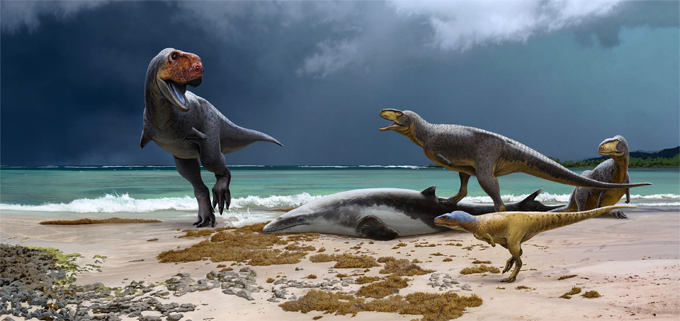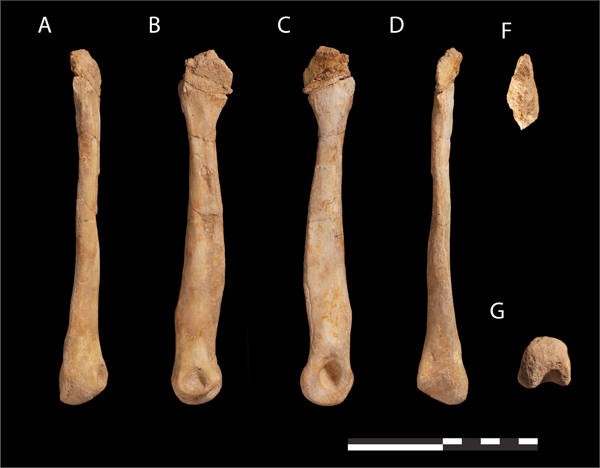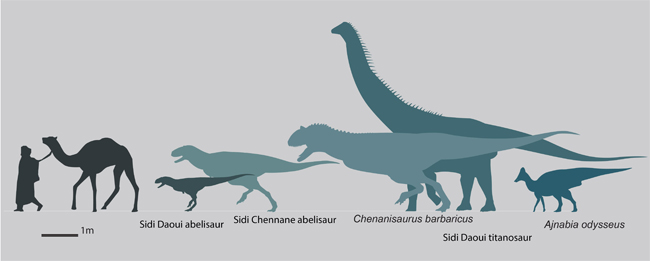Two new abelisaurs have been described from fragmentary fossils from the upper Maastrichtian phosphates of the Ouled Abdoun Basin, in northern Morocco. There were at least three, coeval abelisaurid taxa present in Morocco during the Late Cretaceous. Scientists report a growing body of evidence to suggest that dinosaurs were highly diverse in North Africa prior to the end-Cretaceous mass extinction.
Although the two new abelisaurids have yet to be formally described, the fossils associated with them are thought to represent mature animals and they demonstrate enough autapomorphies for researchers to be confident that they represent new genera.
Writing in the academic journal “Cretaceous Research”, the researchers conclude that these different-sized carnivores co-existed. The break-up of the super-continents led to the establishment of dinosaur dominated regional biotas. The Late Cretaceous dinosaur fauna of North Africa remains relatively unknown in comparison to North America and Asia. The discovery of these fossils indicates that there were several species of predatory dinosaur present in North Africa. The presence of so many predators suggests that dinosaurs were still thriving in Africa immediately prior to the end-Cretaceous mass extinction event.

Picture credit: Andrey Atuchin
Two New Abelisaurs Described from Fragmentary Fossils
The fossils come from the phosphate mines of the Ouled Abdoun Basin. These strata were deposited in a shallow marine environment along the eastern margin of the Atlantic Ocean. One genus, found near the town of Sidi Daoui, is represented by a foot bone (metatarsal) from an abelisaurid about two and a half metres long.

Picture credit: University of Bath
Metatarsal Fossil Shows Unusual Characteristics
The metatarsal shows strong mediolateral compression, a feature present in noasaurids and some early abelisaurids, but absent in most Late Cretaceous abelisaurids. It is distinct from other abelisauroids in the strong constriction and bowing of the shaft in lateral view, and the medial curvature of the bone in anterior view. Bone texture suggests it comes from a mature individual. The small size, gracile proportions and unusual shape of the metatarsal suggest it is not closely related to other latest Cretaceous abelisaurids.
The other fossil specimen, comes from nearby Sidi Chennane. It is a partial right tibia (shin bone) of a theropod estimated to be around five metres in length.
Picture credit: University of Bath
Lead author of the study, Dr Nick Longrich, from the Milner Centre for Evolution at the University of Bath, commented:
“What’s surprising here is that these are marine beds. It’s a shallow, tropical sea full of plesiosaurs, mosasaurs, and sharks. It’s not exactly a place you’d expect to find a lot of dinosaurs. But we’re finding them.”
Revealing a Diverse Late Cretaceous Dinosaur Fauna
Dinosaur fossils from these strata are rare. However, the small number of dinosaur fossils that have been recovered represent five different species – a small hadrosaur named Ajnabia odysseus and a long-necked and as yet unnamed titanosaur. Theropods are represented by the giant abelisaurid Chenanisaurus (C. barbaricus), and the two new abelisaurs.

To read Everything Dinosaur’s blog post about the discovery of Ajnabia: The First Hadrosaurid From Africa.
To read Everything Dinosaur’s article from 2017 about the discovery of Chenanisaurus barbaricus: The Last Dinosaur from Africa.
Everything Dinosaur acknowledges the assistance of a media release from the University of Bath in the compilation of this article.
The scientific paper: “New fossils of Abelisauridae (Dinosauria: Theropoda) from the upper Maastrichtian of Morocco, North Africa” by Nicholas R. Longrich, Erik Isasmendi, Xabier Pereda-Suberbiola and Nour-Eddine Jalil published in Cretaceous Research.
Visit the award-winning Everything Dinosaur website: Everything Dinosaur.







Leave A Comment